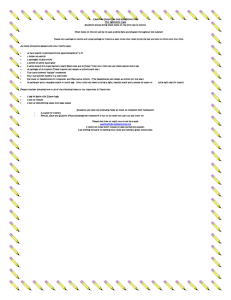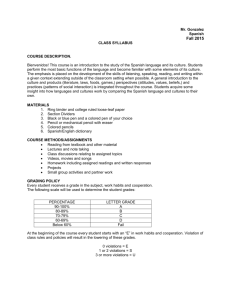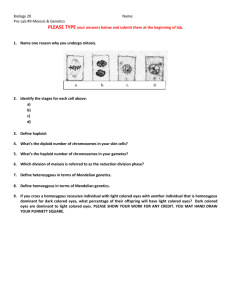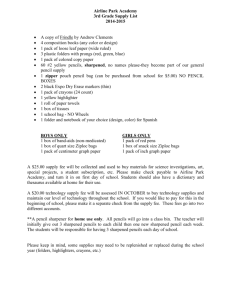Crist ANAGPIC
advertisement
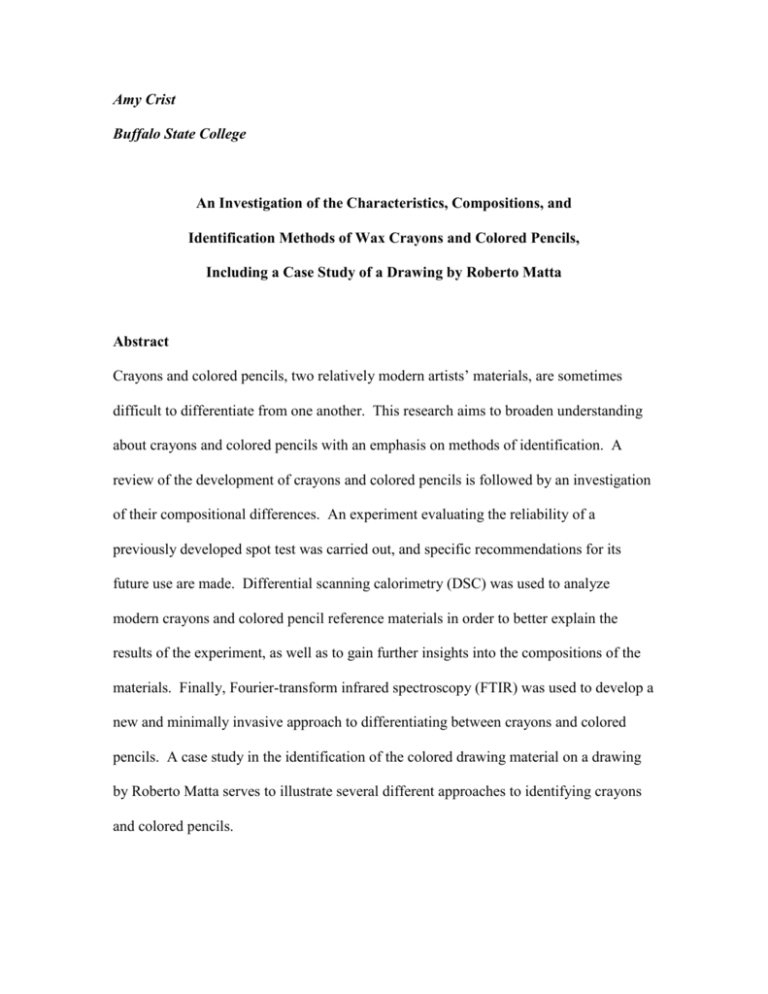
Amy Crist Buffalo State College An Investigation of the Characteristics, Compositions, and Identification Methods of Wax Crayons and Colored Pencils, Including a Case Study of a Drawing by Roberto Matta Abstract Crayons and colored pencils, two relatively modern artists’ materials, are sometimes difficult to differentiate from one another. This research aims to broaden understanding about crayons and colored pencils with an emphasis on methods of identification. A review of the development of crayons and colored pencils is followed by an investigation of their compositional differences. An experiment evaluating the reliability of a previously developed spot test was carried out, and specific recommendations for its future use are made. Differential scanning calorimetry (DSC) was used to analyze modern crayons and colored pencil reference materials in order to better explain the results of the experiment, as well as to gain further insights into the compositions of the materials. Finally, Fourier-transform infrared spectroscopy (FTIR) was used to develop a new and minimally invasive approach to differentiating between crayons and colored pencils. A case study in the identification of the colored drawing material on a drawing by Roberto Matta serves to illustrate several different approaches to identifying crayons and colored pencils. Crist, ANAGPIC 2006 Paper 2 For many of us, crayons were our first medium of artistic expression. They are probably the only artists’ materials handed out at restaurants to pacify bored children, and even the most artistically disinclined person probably has a few colored pencils around the house. While they may be some of the most ubiquitous artists’ materials, conservation research addressing their unique properties is somewhat scarce. Through visual examination, the reevaluation of a previously developed spot test, and also the use of instrumental analysis, this research project aims to promote a more in-depth understanding of crayons and colored pencils, especially with regard to their compositions and methods of identification. Much like a Kleenex or a Xerox, a crayon is practically synonymous with a Crayola. The use of the word crayon, however, predates our present connotation of a waxy, colored drawing stick. The derivation of the term is from the French craie, meaning chalk (Simpson and Weiner, 2002). Natural chalks, used virtually straight from the earth, were some of the earliest drawing materials (Watrous 1957, 91). Because natural chalks have a limited color range and vary in composition and working properties, man-made versions of natural chalks were developed. Known as fabricated chalks and pastels, these drawing materials consist of ground pigments mixed with a binding medium, typically gum arabic or gum tragacanth (Watrous 1957, 112). One inherent characteristic of chalks and pastels is that they are leanly bound and produce friable marks. The great innovator Leonardo da Vinci is an often-cited early proponent of the addition of wax to powdery drawing materials to produce a more permanent mark. In one of his notebooks, da Vinci wrote, “To make points for colouring dry. Temper with a little wax and it will not come off . . . ” (Watrous 1957, 118). Crist, ANAGPIC 2006 Paper 3 Throughout the seventeenth and eighteenth centuries, artists’ manuals periodically recommend adding a waxy component to drawing materials in order to prevent smudging (Watrous 1957, 118-119). The widespread acceptance and employment of wax crayons owes a debt to Alois Senefelder, inventor of lithography in the late eighteenth century. In traditional lithography, the artist uses a greasy material to draw an image onto the printing stone. The hardness of the crayon used on the stone affects the manner in which the stone holds and transfers the printing ink. Soft crayons produce rich, deep black tones, while hard crayons produce lighter tones. By beginning the drawing with hard crayons and gradually building up to softer crayons, a luminous, velvety tone can be produced (Antresian and Adams 1971, 29). The demand for high quality, uniform litho crayons, coupled with a desire for non-smudging drawing materials resulted in our modern wax crayons. Binney and Smith introduced Crayola crayons in 1903, as an inexpensive drawing material for students (www.binney-smith.com/timeline, 2002). European manufacturers, such as Caran d’Ache, would soon market crayons to artists. Despite their grade-school connotations, artists such as Pablo Picasso, Arshile Gorky, and Henry Moore have employed crayons in their artwork (Ellis and Yeh 1998, 51). Returning to the issue of terminology, the term crayon is still used as a general term to describe any dry drawing material. Drawing scholar Joseph Meder proposes, in the interest of a uniform vocabulary, a more strict application of the terms crayon, chalk, and pastel. The word crayon might be restricted to those fabricated sticks which have greasy or waxy binders; this would leave the word chalk to refer only to natural black, red, and white Crist, ANAGPIC 2006 Paper 4 chalks and pastel to refer to colored sticks with either very little binder or a gum binder (Meder 1978, v. 1, 106). If we are to accept Meder’s recommendation, colored pencils are merely a subset of the crayon category. However, due to their development independent of crayons, it is here proposed that colored pencils constitute a distinct category of drawing materials. While crayons evolved from chalks and pastels, the colored pencil owes its development most principally to the evolution of writing materials. The derivation of the term pencil comes from the Latin pencillum, an early writing brush that consisted of a small gathering of animal hairs held in a thin reed (Petroski 1998, 15). The woodencased graphite pencil embodies the best qualities of its predecessors the pencillum, which produced dark, thin lines, and the metal point, which was dry but often faint (Petroski 1998, 17). According to pencil champion Henry Petroski, the primary advantage of the engineering wonder that is the pencil is its sharp, precise point (Petroski 1998, 196). It is therefore not surprising that someone thought to add another feature to the pencil’s many attributes – color. German pencil maker Johann Staedtler is credited with first producing and marketing colored pencils in the mid-nineteenth century (Petroski 1998, 146-147). By the early years of the twentieth century colored pencil sets contained 15 to 20 different colors. They had less wax and less pigment than modern colored pencils, and were not marketed for artistic use. By 1924, the Faber pencil company was producing colored pencils in over 60 colors and marketing them to artists. Schwann Stabilo, Caran d’Ache, and Berol Prismacolor were quick to follow suit (Ellis and Yeh 1998, 50). Crist, ANAGPIC 2006 Paper 5 The basic ingredients in crayons and colored pencils are the same: wax, colorants, and fillers. The wax component can be homogeneous or a mixture, colorants include mineral pigments and organic colorants, and the filler is typically kaolin. Specific ingredients and proportions vary by manufacturer, color, and quality. One of the most significant differences between colored pencils and crayons is a physical one. Colored pencils are generally encased in wood, whereas wax crayons are usually manufactured as sticks. Complementary to the wood-encased format of colored pencils is their generally harder composition compared to wax crayons. In some instances, it is obvious whether a drawing was created with colored pencils or wax crayons; other times, it is less clear. The inspiration for this research project was a drawing by the surrealist artist Roberto Matta (Fig. 1). The drawing was in a house fire and considered a total insurance loss. It was donated to the conservation department in 1976, at which time a student treated the drawing, greatly reducing the soot and water damage. Unfortunately, nothing could be done for the charred paper support. Matta used primarily graphite to Figure 1. Roberto Matta, Untitled create the menacing creatures that are seen throughout the drawing. Further visual interest was achieved with bright bursts of pink and blue and subtle highlights of peach Crist, ANAGPIC 2006 Paper 6 and green. It is not immediately clear whether the colored drawing material is crayon, colored pencil, or a combination of both. Matta, self-described as unconstrained by moral or aesthetic prejudice, was known to have employed a wide variety of drawing materials, including colored pencil, crayon, pastel, chalk, and even an unusual polychrome pencil that changed color as he drew (Matta 1975) and (Calas 1975). In order to perform a more skillful visual assessment of the Matta drawing, especially since some of the media may have been altered by the fire, it was helpful to first identify some general characteristics of colored pencil and crayon marks. A useful feature to examine first is the width of the lines as they compare to the intensity of color. Thin, but intensely colored lines are a strong indication of colored pencil, while thicker lines or broad marks more than a few millimeters wide indicate crayon. In addition to some very prominent wide marks (Fig. 2), the Matta contains a few passages of intensely colored thin lines (Fig. 3). These marks are narrow, precise, and applied in an energetic manner. Achieving these qualities with a crayon seems highly improbable. Figure 2. Magnified detail of Untitled (ruler indicates millimeters) Figure 3. Magnified detail of Untitled (ruler indicates millimeters) Crist, ANAGPIC 2006 Paper 7 Best seen under magnification, the most fundamental difference between a crayon mark and a colored pencil mark is the way the material transfers to the paper. A colored pencil tends to deposit material onto the paper in finer amounts compared to a crayon (Figs. 4 and 5). When marking with a crayon, waxy chunks spall off the stick and adhere to the highest points of the paper. The waxy material does not tend to surround the paper fibers, nor does it nestle into the interstices of the paper. Colored pencil, however, tends to adhere to the paper in smaller, more granular deposits. With repeated applications of colored pencil, the material gradually and evenly accumulates on the paper, whereas repeated crayon marks tend to clump together. A rougher paper texture tends to exaggerate these characteristics, while a smoother paper tends to mute them. Figure 4. Deposition of colored pencil onto paper (ruler indicates millimeters) Figure 5. Deposition of crayon onto paper (ruler indicates millimeters) The Matta drawing was examined under magnification with careful attention paid to the interaction of support and media. The paper support is a very smooth, medium weight, machine-made paper. It was hypothesized that if Matta’s drawing material Crist, ANAGPIC 2006 Paper 8 sustained damage during the fire, these are the visual characteristics that would be most affected. Marks on the more charred areas of the paper were therefore considered with a degree of skepticism. A fine, granular application of blue drawing material, unlikely achieved with a crayon, can be observed in several passages (Fig. 6). Even if this material melted in the fire causing the edges to spread, it seems too finely applied to be crayon. Further evidence for the use of colored pencils, the green marks were layered over other colors, mixing smoothly and remaining transparent (Fig. 7). Figure 6. Magnified detail of Untitled (ruler indicates millimeters) Figure 7. Magnified detail of Untitled (ruler indicates millimeters) Also related to the paper texture, the edges of marks are often very characteristic. Colored pencils usually have smooth edges, while crayon marks often have irregular edges, and are sometimes even three-dimensional. On the Matta, the edges are all quite smooth, especially in the boldly applied areas (Fig. 2). For a crayon to be applied thickly enough to create such smooth edges, three-dimensional buildup would likely be present. Crist, ANAGPIC 2006 Paper 9 Of course, if the drawing material melted in the fire, the edges of uneven crayon lines could become uniform, and three-dimensional build-up could melt flat. Though preliminary examination seemed to indicate that Matta used colored pencils, a more confident conclusion was impeded by condition issues. As is often the case in conservation, when our eyes cannot solve a problem, we turn to other methods of identification. The hot needle test was developed by conservators in 2002 as a method for differentiating among various types of wax-based drawing materials (Reid, McGuinne, and Fields 2002). To perform the test, a blunted needle is heated to 80 ºC. With the artifact placed on a blotter, a square of unbuffered photographic storage paper is placed above the artifact, and a square of silicone release paper is placed on top of the photographic storage paper to protect the artifact. The hot needle is brought into contact with the work of art for 5 seconds and then removed. The photographic storage paper is examined, and the way in which the drawing material transfers to the paper indicates its identity. Colored pencils should produce a slight halo and crayons should produce an intense halo. The developers of the test report that it is simple, inexpensive, more conclusive than various forms of instrumental analysis, and causes little to no damage to the artifact. Intrigued by the reported success of this technique, an attempt was made to replicate it. The test can be assembled from equipment that is probably available in most conservation labs. However, initial experiments showed that the test is not immediately simple and straightforward. Controlling the temperature of the needle is absolutely essential. In order to do this, a thermocouple was wired to the tip of the needle in order Crist, ANAGPIC 2006 Paper 10 to monitor the temperature (Fig. 8). Another difficulty of this test is the subjective interpretation of the results. Crayons tend to transfer a different type of mark than colored pencils, but the difference is subtle (Figs. 9 and 10). As practice with the test continued, some questions surfaced. How reliable is this test? How do Figure 8. A thermocouple attached to the hot needle with a copper wire the results vary according to the skill of the user? How does the reliability of the test compare to the reliability of visual examination? To answer these questions in a statistically sound way an experiment was designed. Figure 9. Examples of the way colored pencils transfer to the photographic storage paper when tested with the hot needle (ruler indicates millimeters) Figure 10. Examples of the way crayons transfer to the photographic storage paper when tested with the hot needle (ruler indicates millimeters) The experiment was conducted in two separate rounds of testing; one round was performed by a tester who had experience with the test, and one round performed by a tester who had little experience with the test. Within each round of testing, samples were evaluated with the hot needle test only, samples were evaluated by visual examination only, and samples were evaluated by a combination of visual examination and the optional use of the hot needle test. The author served as the experienced tester, and twenty volunteers collectively served as the inexperienced tester. The twenty volunteers Crist, ANAGPIC 2006 Paper 11 were statistically regarded as one tester. During the course of testing, all testers chose from the following answer choices: crayon, colored pencil, or undecided. In order to create a large pool of meaningful samples, this experiment was only concerned with contemporary, un-aged reference materials. Out of an abstract pool of 525 samples, which varied by manufacturer, color, and intensity of media application, 200 samples were randomly chosen for testing. Once all the tests were performed, the data was processed. With regard to the experienced tester, out of 200 samples, about 175 were correctly identified by visual assessment alone, corresponding to about 87% accuracy. The needle test was less accurate, correct about 79% of the time. But when visual assessment was combined with the needle test, the best result was obtained, 90% reliability. The results for the inexperienced tester were quite different. By visual identification alone, accuracy was about 73%. There was a steep decline in accuracy with the needle test alone, down to 58%. Keep in mind that, 50% would be random guessing. Unlike the combined result for the experienced tester, the combined assessment for the inexperienced tester was 72% reliability, statistically equal to visual assessment alone. The obvious, and encouraging result of this experiment is that, with practice, assessment can be very reliable. The obvious discouraging result of the experiment is that to employ this test, a test that is useful for only a very particular type of artifact, a great deal of effort must be put forth. Since the hot needle test is based on melting characteristics, the thermal properties of the reference materials were directly analyzed with differential scanning calorimetry, or DSC. DSC is an instrument that measures heat flow into or out of a sample in relation to a reference. Forty-two reference samples of colored pencils and crayons were Crist, ANAGPIC 2006 Paper 12 analyzed with DSC. The use of DSC was meant to answer three general questions. First, at what temperature do crayons and colored pencils melt? Second, is the waxy component of crayons and colored pencils homogenous or a mixture? And third, can thermal analysis help to explain any of the difficulties of the hot needle test? In the interest of time, only the melting point data will be presented here, as it is the most practical yield of this analysis, helpful to a conservator proposing or performing a treatment that may involve heat. The onset melting point, the point at which a material begins to melt, can be calculated from the data obtained by DSC. The average melting points for crayons and colored pencils are statistically the same. The average for all the samples is 42.8 ºC. Color, brand, and quality had no significant effect on the melting points. Though colored pencils and crayons will begin to melt at approximately the same temperature, the damage potential for crayons is higher, due to the higher proportion of wax. Conservators should be aware of this melting danger during treatment. A thermocouple can easily be adapted for use with heated tools to help monitor temperature during treatment. Combining the needle test with visual examination is fairly accurate with practice, but as seen with the Matta, visual information is sometimes obscured. And it is not always practical to spend a lot of effort perfecting an esoteric technique. Therefore, an altogether different approach to identification, based on compositional differences, was developed. FTIR is ideally suited for this purpose because it is capable of detecting both organic materials, like waxes, and inorganic materials, like fillers. Generally, crayons are softer and waxier, and colored pencils are harder and more granular. This corresponds to a difference in the ratio of wax to filler. FTIR cannot provide quantitative information, Crist, ANAGPIC 2006 Paper 13 but it can detect characteristic trends that relate to quantity, such as a ratio of wax to filler. Infrared spectra of 52 reference samples were collected and analyzed. The spectra tended to be similar, even between colored pencils and crayons. Almost all the spectra contained characteristic peaks for kaolin, as well as peaks characteristic of the long chain hydrocarbons present in waxy substances (Fig. 11). Of these characteristic groups, one peak was selected for comparison. The areas for these two peaks were determined, the ratios between the peaks were Figure 11. The spectrum of a crayon sample compared to reference spectra for beeswax and kaolinite calculated, and a trend was observed. The average ratio for colored pencils is far lower than that of crayons. Further experimentation continued in order to determine a viable method for analyzing an artifact. Two methods were explored, and then employed on the Matta – one in situ with the -ATR objective, and one by taking very small samples prepared with the diamond compression cell. The later method yielded ratios indicative of colored pencil. Visual assessment indicated that Matta used colored pencil. FTIR assessment also indicated that Matta used colored pencil. To complete this case study, the needle test Crist, ANAGPIC 2006 Paper 14 was performed on the Matta, and it confirmed the results of the other two methods. Here are some final conclusions and observations from this research that may prove useful. If you choose to use the needle test, practice first. When employing the needle test, perform it on more heavily applied areas, do not use it to identify white marks, and be aware that it can leave a mark on the artifact. And when studying any type of drawing material, practice looking, practice drawing, and remember to trust your eyes. Acknowledgements This presentation was adapted from the senior specialization project of the same title completed at the Buffalo State College graduate program in art conservation. I would like to acknowledge the support of the faculty, staff, and supporting institutions of this program. Particular thanks goes to Dr. Gregory Smith, Dr. Anikó Bezúr, Irene Brückle, Stephanie Lussier, Dr. Chaitali Ghosh, the testing volunteers, James Downing, and Marieka Kaye. Works Referenced Antreasian, G. and C. Adams. 1971. The Tamarind book of lithography: art and techniques. New York: Harry N. Abrams Inc. Calas, N. 1975. Introduction. In Matta: a totemic world, paintings, drawings, and sculpture, January 11-February 15, 1975. New York: Andrew Crispo Gallery. Ellis, M. H. and M. B. Yeh. 1998. The history, use and characteristics of wax-based drawing media. The paper conservator 22:48-55. Matta: a totemic world, paintings, drawings, and sculpture, January 11-February 15, 1975. 1975. New York: Andrew Crispo Gallery. Crist, ANAGPIC 2006 Paper 15 Meder, J. 1978. The mastery of drawing, trans. W. Ames. New York: Abaris Books, Inc. Petroski, H. 1998. The pencil. New York: Alfred A. Knopf. Reid, Z., N. McGuinne, and J. Fields. 2002. The Yeats archive: a method of identifying wax crayon. In Works of art on paper, books documents, and photographs: contributions to the Baltimore conference, 2-6 September 2002, eds. V. Daniels, A. Donnithorne, and P. Smith. London: International Institute for Conservation of Historic and Artistic Works. 176-179. Simpson, J. A. and E. S. C. Weiner, eds. 2002. The Compact Oxford English dictionary. London: Oxford University Press. Watrous, J. 1957. The craft of old-master drawings. Madison: University of Wisconsin Press. www.binney-smith.com/timeline (accessed March 7, 2005).
